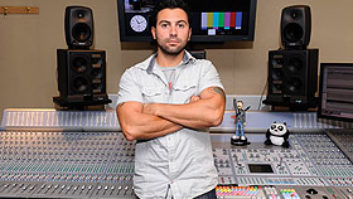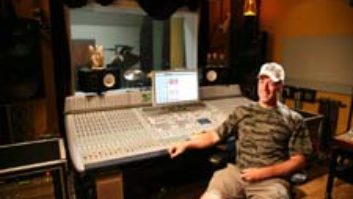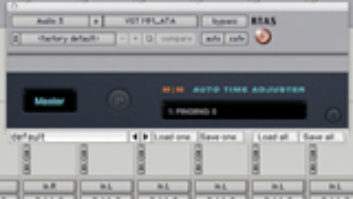As a longtime Pro Tools user and the owner of the first — and still largest — ICON console, I have discovered, created and stolen some great tricks. Many of these seem more common sense than trickery, but as Voltaire once said, “Common sense is not so common.” My expertise leans greatly toward post-production, so many of the references will be about film and TV mixing.
FIRST THINGS FIRST
My first bit of advice isn’t really a tip — it’s a necessity: Upgrade to Pro Tools Version 6.9. I’ve been using V. 6.9.3 for a while now — a benefit of being a Digidesign beta tester — and I can’t go back. In my opinion, V. 6.9 is the biggest mixing update since V. 4.3, when the ProControl was introduced. Auto-match, auto-merge, null-point trim mode, non-destructive solo, inline console — there are too many improvements to list here, but the tips below assume you have an ICON and Pro Tools V. 6.9.
ONE-SHOT ACTIVATION
Several features embedded in V. 6.9 are specifically designed for D-Control and D-Command. On every setup, I use D-Control’s ability to activate all automation parameters in one shot. If EQ or dynamics are focused and the Auto button is lit, then just touch any rotary knob while holding the OPT key. The same can be accomplished with any insert that’s accessed with Custom fader “plug-in” mode or editing a plug-in on a channel strip while holding CTRL + OPT + CMD while the Do to All button is lit.
PAN FOR PARAMETERS, TOO
Beyond panning, the new joystick panners are also useful for editing plug-ins. In the Pan Mode window, press Custom on the touchscreen, then either X axis or Y axis. You can then assign a value to these by touching any rotary knob or fader that is on the focused channel. This can be useful for EQ sweeps or even Doppler-bys in GRM tools. The Auto mode lets you do perfect pans by moving the joystick to your end pan position and then hitting Punch 1 when you want to start the pan. You must be rolling to do this, and the pan duration is determined by the glide time you have selected in the console’s refs section.
THE NAME GAME
Glazed over in the manual, a simple but effective trick is the ability to name custom fader banks. If you select a bank and hold CTRL while double-tapping the bank’s Edit button, a window will appear on your Pro Tools screen to name the bank. The bank name will then show in the center info section in D-Control or D-Command when the Bank Sel button is pressed.
SHUN THE MOUSE AND TRACKBALL
The real key to quick and efficient mixing is avoiding the mouse and trackball as Pro Tools has key commands for almost everything. Become familiar with the key commands document supplied with Pro Tools V. 6.9. This may not seem like a great tip for the ICON, but they do apply. Most everything you can do onscreen with the mouse, you can do on the console. The OPT key (or ALT for the Windows world) with a click on an onscreen parameter resets that parameter to its default. OPT + touching a fader on the console snaps that fader to zero. As CMD + dragging a value onscreen will adjust in fine scale, CMD + any rotary knob will also adjust in fine scale on the console. CMD + CTRL while clicking a value onscreen will view that value’s automation. Hold CMD + CTRL and touch any knob or fader to bring that automation to view.
GLIDE AUTOMATION
I often use the “Write to all enabled parameters” setting for EQs, reverbs, pans, etc., but frequently need to do this in the middle of a clip. Glide lets you morph between a series of settings. When I have a sudden jump in automation, I select the out point of where I would like to glide to, suspend automation, drag my selection back to my glide In point and then “Glide to all enabled parameters.” This function now exists in ICON’s second Actions page.
MULTIPLE CUSTOM FADERS
Having the left and right Custom Faders sections was originally intended to let two mixers have custom layouts on the same system, but this is very useful in single-mixer applications. On the one side, I map the most frequently accessed faders for a given element so that I can easily switch between elements and not move much from the sweet spot. On the other Custom Fader set, I map my masters chain for particular elements. I may switch between two dialog chains that each have an EQ, compressor and the insert for my CEDAR DNS-2000. Using custom mapping, I can assign the master volume, the compressor’s threshold and make-up, the high- and lowpass and a notch for my EQ, and the seven parameters for my CEDAR all to one bank of faders.
AUTOMATION COPY/PASTE
One of the frustrations of mixing with Pro Tools is its inability to group pans and other functions. A good workaround is Pro Tools’ ability to copy all layers of automation. When viewing any automation parameter, highlight the desired area when you have created some automation and then hold CMD + CTRL + “C.” A normal paste (CMD + “V”) will paste all levels of automations, including multichannel pans, inserts and send automation. This is useful when you’ve created a complicated task on one region but wish to duplicate it on another region at the same time or elsewhere in the timeline.
Brian Slack is the president of Widget Post in Los Angeles.



